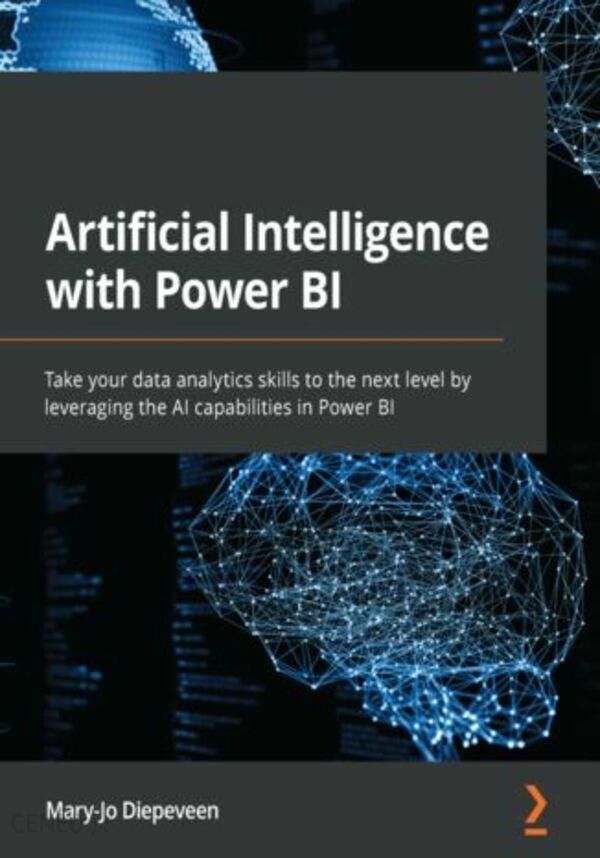Opis
Artificial Intelligence with Power BI (E-book)
The artificial intelligence (AI) capabilities in Power BI enable organizations to quickly and easily gain more intelligent insights from unstructured and structured data.This book will teach you how to make use of the many AI features available today in Power BI to quickly and easily enrich your data and gain better insights into patterns that can be found in your data.Youll begin by understanding the benefits of AI and how it can be used in Power BI. Next, youll focus on exploring and preparing your data for building AI projects and then progress to using prominent AI features already available in Power BI, such as forecasting, anomaly detection, and Q&A. Later chapters will show you how to apply text analytics and computer vision within Power BI reports. This will help you create your own Q&A functionality in Power BI, which allows you to ask FAQs from another knowledge base and then integrate it with PowerApps. Toward the concluding chapters, youll be able to create and deploy AutoML models trained in Azure ML and consume them in Power Query Editor. After your models have been trained, youll work through principles such as privacy, fairness, and transparency to use AI responsibly.By the end of this book, youll have learned when and how to enrich your data with AI using the out-of-the-box AI capabilities in Power BI. Spis treści:Artificial Intelligence with Power BIContributorsAbout the authorAbout the reviewersPrefaceWho this book is forWhat this book coversTo get the most out of this bookDownload the example code filesDownload the color imagesConventions usedGet in touchShare Your ThoughtsPart 1: AI FundamentalsChapter 1: Introducing AI in Power BIWhat do we expect from a data analyst?What is a data analyst?Connecting to dataVisualizing dataWhat is AI?Understanding the definition of AIUnderstanding machine learningUnderstanding deep learningUnderstanding supervised and unsupervised learningUnderstanding algorithmsWhat is the data science process?Why should we use AI in Power BI?The problems with implementing AIWhy AI in Power BI is the solutionWhat are our options for AI in Power BI?Out-of-the-box optionsCreating your own modelsSummaryChapter 2: Exploring Data in Power BITechnical requirementsUsing the sample dataset on world happinessHow to interpret this datasetImporting the world happiness dataset into Power BIWhat to look for in your dataUnderstanding data quantityUnderstanding data qualityUsing data profiling toolsColumn qualityColumn distributionColumn profileUsing visuals to explore your dataLine chartsBar chartsHistogramsScatter plotsmatplotlibSummaryChapter 3: Data PreparationFixing the structure of your dataWorking with structured dataFixing the structure of semi-structured dataFixing the structure when working with imagesWorking with missing dataHow do you find missing data?What do you do with missing data?Mitigating biasHow to find biasHow to mitigate bias in your datasetHandling outliersSummaryPart 2: Out-of-the-Box AI FeaturesChapter 4: Forecasting Time-Series DataTechnical requirementsData requirements for forecastingWhy use forecasting?Time-series dataUsing an example tourism dataAlgorithms used for forecastingThe benefit of using an out-of-the-box featureUnderstanding how forecasting is calculated in Power BIOptimizing forecasting accuracy in Power BIUsing forecasting in Power BISummaryFurther readingChapter 5: Detecting Anomalies in Your Data Using Power BITechnical requirementsWhich data is suitable for anomaly detection?Why use anomaly detection?Data requirements for anomaly detectionUnderstanding the logic behind anomaly detectionThe algorithms behind Microsofts anomaly detection featureNo need to label your dataFast and powerful analysisUsing anomaly detection in Power BIImporting the sample dataset into Power BIEnabling anomaly detection in Power BISummaryFurther readingChapter 6: Using Natural Language to Explore Data with the Q&A VisualTechnical requirementsUnderstanding natural language processingUsing natural language in programsUnderstanding natural language for data explorationPreparing data for natural language modelsCreating a Q&A visual in Power BIAdding a Q&A visualUsing the Q&A visualOptimizing your Q&A visualExploring the Q&A setupImproving the Q&A experienceUsing feedback to improve the model over timeSummaryFurther readingChapter 7: Using Cognitive ServicesTechnical requirementsUnderstanding Azures Cognitive ServicesCreating a Cognitive Services resourceUsing Cognitive Services for LUUsing Azures Text AnalyticsCreating question answering from a knowledge baseUsing Cognitive Services for CVUnderstanding Azures Computer VisionUsing Azures Custom VisionUsing the Face serviceSummaryChapter 8: Integrating Natural Language Understanding with Power BITechnical requirementsUsing Language APIs in Power BI DesktopUsing AI InsightsUsing Power Query EditorVisualizing insights from text in reportsVisualizing text with a Word CloudSummaryChapter 9: Integrating an Interactive Question and Answering App into Power BITechnical requirementsCreating a question answering serviceUnderstanding the application of question answeringConfiguring a question answering serviceCreating an FAQ app with Power AppsCreating a new app with Power AppsAdding Power Automate to call the question answering serviceConnecting Power Automate to Power AppsIntegrating the FAQ app with Power BIImproving the question answering modelSummaryChapter 10: Getting Insights from Images with Computer VisionTechnical requirementsGetting insights with Computer Vision using AI InsightsUsing the Vision option of AI InsightsConfiguring Custom VisionPreparing the data for Custom VisionTraining the model in Custom VisionEvaluating classification modelsPublishing your Custom Vision modelIntegrating Computer Vision or Custom Vision with Power BIUsing visuals to show a reel of images in a reportStoring data and ensuring it is anonymously accessibleImproving the Custom Vision modelSummaryPart 3: Create Your Own ModelsChapter 11: Using Automated Machine Learning with Azure and Power BITechnical requirementsUnderstanding AutoMLUnderstanding the ML processImproving the performance of an ML modelWhen to use AutoMLCreating an AutoML experiment in Azure MLCreating an Azure ML workspace and resourcesConfiguring an AutoML runDeploying a model to an endpointIntegrating the model with Power BISummaryChapter 12: Training a Model with Azure Machine LearningTechnical requirementsUnderstanding how to train a modelUnderstanding the machine learning processWorking with Azure MLCreating Azure ML assetsTraining a model with Azure ML DesignerConfiguring an Azure ML Designer pipelineDeploying a model for batch or real-time predictionsGenerating batch predictionsGenerating real-time predictionsIntegrating an endpoint with Power BI to generate predictionsSummaryChapter 13: Responsible AIUnderstanding responsible AIProtecting privacy when using personal dataRemoving personally identifiable informationUsing differential privacy on personal dataCreating transparent modelsUsing algorithms that are transparent by designExplaining black-box modelsCreating fair modelsIdentifying unfairness in modelsMitigating unfairness in modelsSummaryWhy subscribe?Other Books You May EnjoyPackt is searching for authors like youShare Your Thoughts
Pozostałe E-booki
ginu seagrams, poki slodycze, prezent dla dziecka na chrzest, persil against bad odors, pudełeczko na prezent, house of asia pad thai, somersby truskawka, mefisto sklep, imię inka, bandaż jałowy, blak car, filtry do herbaty jan niezbędny, ba baton, hp650, adresowanie koperty dla nowożeńców, ciastka kokosowe, torba sniadaniowa, ursus c 330 zabawka, gin gordons pink, slodkie mleko, cd hd
yyyyy




